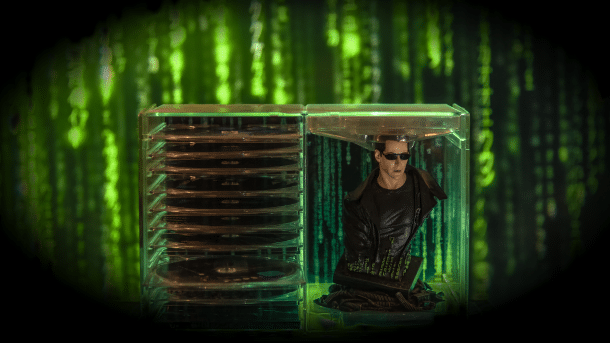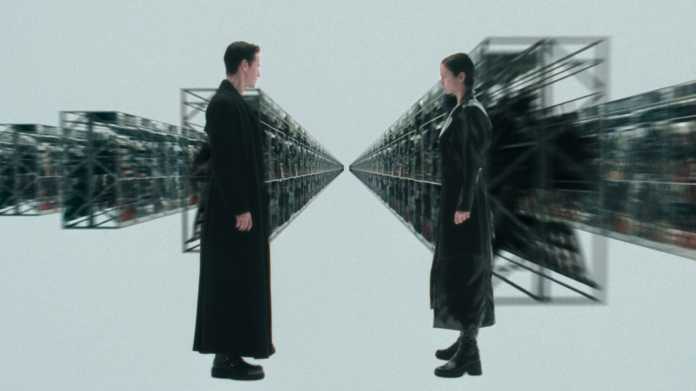25 years of "The Matrix": Celebrating the movie with the red pill
Humanity is trapped in a simulation while machines rule the world: 25 years ago, "The Matrix" hit theaters and became a milestone in popular culture.

DVD collector's boxes with movie characters and screensavers were "a thing" in the 1990s.
(Bild: Nico Ernst)
A woman in paint and leather jumps from a skyscraper across a busy street. Mercury flows up the arm of a startled Keanu Reeves. Grim-faced men in black suits smash concrete pillars with their bare fists. Green letters drip down the screen like rain. Kung-fu fights in slow motion. And: "Guns, lots of guns."
The trailer for "The Matrix" lured viewers with spectacular images and ended with a promising sentence: "Unfortunately, no one can be told what the Matrix is. You have to see it for yourself." That is, of course, pure nonsense.
Empfohlener redaktioneller Inhalt
Mit Ihrer Zustimmmung wird hier ein externes Video (Kaltura Inc.) geladen.
Ich bin damit einverstanden, dass mir externe Inhalte angezeigt werden. Damit können personenbezogene Daten an Drittplattformen (Kaltura Inc.) übermittelt werden. Mehr dazu in unserer Datenschutzerklärung.
25 years later, even people who have never seen the movie can explain what the Matrix is: The plot has seeped into pop culture as deeply as "Star Wars". The script cleverly mixes common paranoia fodder such as mass surveillance and the manipulation of public perception into a sinister sci-fi cocktail.
Traditional story, revolutionary effects
"The Matrix" follows a fairly familiar structure: A doubting young man meets an older mentor and learns supernatural skills to stand up to an overpowering opponent. This form of heroic epic was already old hat when "Star Wars" came out in 1977.
And yet "The Matrix" set new standards – both in terms of effects and plot. Back in 1999, "bullet time" was the effect which made the biggest splash: The camera circles around the actors with breathtaking speed as they fight each other in slow motion. Another unusual wrinkle was the combination of martial arts stunts with the use of firearms.
The Matrix – Most memorable moments (9 Bilder)

Many viewers were particularly fascinated by the idea that they themselves might be living in an illusory world. Variations of this idea can be found in Buddhism, Plato's Allegory of the Cave, and Descartes. "The Matrix" added a sci-fi twist: Not only does a wise child in the movie say, "There is no spoon." Outside the simulation, the only cutlery to be seen are sporks, a mixture of fork and spoon.
Have a brief look at your kitchen drawer: Does this mean that we – you and me, perhaps even your cat – are living in an illusion? To this day, the question is a rewarding topic for feature articles, scientific papers, and stoner conversations.
(Incidentally, the fact that the Nokia 8110 cell phones featured in the movie have a spring-loaded snap mechanism speaks against the theory. In the real world, you have to push the 8110 open by hand; only the distinctly different looking 7110 snaps open as shown in the movie. Should this paragraph disappear, it was just a glitch in the matrix).
A bumpy road
The idea for "The Matrix" came to the Wachowskis after they had sold their first screenplay, "Assassins" (1995). What was supposed to be their first triumph turned out to be a bitter experience: The result diverged so far from the original script that they tried to have their names removed from the credits. To prevent a similar situation with "The Matrix", the Wachowskis insisted on directing it themselves – something the studio initially refused.
First, however, the Wachowski sisters wrote and shot the thriller "Bound" (1996), with a small cast and few effects. Matrix producer Joel Silver liked to say that the Wachowskis shot "Bound" to prove to film studio Warner Bros that they could also make "The Matrix". As a work sample, so to speak.
Lana Wachowski later denied this story. However, various people involved in "Bound" were carried over to "The Matrix", including cinematographer Bill Pope, composer Don Davis and actor Joe Pantoliano.
After the Wachowskis had created sophisticated designs and comprehensive storyboards with comic artists Geoff Darrow and Steve Skroce, Warner Bros finally gave the go-ahead. To get the most out of the tight 60 million US dollar budget, the majority of the film was shot in Sydney, Australia.